World Radio Day, celebrated on February 13th, is a fascinating observance that emphasizes the pivotal role of radio in communication, culture, and development. It’s a day to recognize the power of this medium in connecting people worldwide. Understanding its significance is crucial, as it sheds light on the impact of radio in our lives. In line with this, below, we have curated a quiz to test your knowledge and appreciation of this vital tool of communication.

General Knowledge Quiz on World Radio Day
World Radio Day is celebrated on February 13th each year to recognize the profound impact of radio in our lives. This observance holds immense significance as it underscores radio’s role in fostering dialogue, information dissemination, and cultural exchange. Radio has the unique ability to reach even the most remote and marginalized communities, making it a powerful tool for promoting education, empowerment, and social cohesion. By celebrating World Radio Day, we acknowledge the vital role this medium plays in promoting freedom of expression and access to information, while also honouring the countless broadcasters who strive to keep us informed and connected through the airwaves.
Following we have provided MCQs on the topic of “World Radio Day”.
Q1. When is National Radio Day celebrated?
A. August 13
B. February 13
C. July 20
D. September 6
Correct Answer: A. August 13
Q2. Which inventor is credited with the development of the first practical radio receiver?
A. Thomas Edison
B. Alexander Graham Bell
C. Guglielmo Marconi
D. Lee De Forest
Correct Answer: D. Lee De Forest
Q3. What is the term for the process of transmitting radio waves from a sender to a receiver?
A. Modulation
B. Transmission
C. Amplification
D. Reception
Correct Answer: B. Transmission
Q4. What famous event, directed by Orson Welles, caused widespread panic in the United States when it aired on the radio in 1938?
A. The Great Depression
B. The Hindenburg disaster
C. The War of the Worlds
D. The Titanic sinking
Correct Answer: C. The War of the Worlds
Q5. Which element is used in the construction of vacuum tubes, an essential component in early radio technology?
A. Copper
B. Silicon
C. Vacuum
D. Glass
Correct Answer: D. Glass
Q6. What is the range of frequencies typically used for AM radio broadcasting?
A. 530 kHz to 1700 kHz
B. 88 MHz to 108 MHz
C. 5350 kHz to 16050 kHz
D. 100 MHz to 1000 MHz
Correct Answer: A. 530 kHz to 1700 kHz
Q7. Which radio station is known for its famous call sign “This is London” during World War II broadcasts?
A. Radio Moscow
B. BBC Radio
C. Radio Free Europe
D. Radio Vichy
Correct Answer: B. BBC Radio
Q8. What technology replaced vacuum tubes in most modern radio equipment and electronic devices?
A. Transistors
B. Microprocessors
C. Diodes
D. Capacitors
Correct Answer: A. Transistors
Q9. Which radio host is famous for his “Golden Voice” and his charitable contributions to the homeless?
A. Rush Limbaugh
B. Howard Stern
C. Casey Kasem
D. Ted Williams
Correct Answer: D. Ted Williams
Q10. What is the term for the interference that occurs when two radio signals on nearby frequencies mix and produce unwanted noise?
A. Crosstalk
B. Feedback
C. Interference
D. Static
Correct Answer: C. Interference
Q11. What is the name of the international organization that coordinates radio frequency allocations worldwide to ensure interference-free communication?
A. International Telecommunication Union (ITU)
B. Federal Communications Commission (FCC)
C. National Aeronautics and Space Administration (NASA)
D. European Space Agency (ESA)
Correct Answer: A. International Telecommunication Union (ITU)
Q12. Which of the following is not a common radio broadcasting band?
A. AM Band
B. FM Band
C. HF Band
D. SW Band
Correct Answer: C. HF Band
Q13. Which radio format is known for playing contemporary and popular music, often targeting younger audiences?
A. News/Talk
B. Classical
C. Top 40
D. Jazz
Correct Answer: C. Top 40
Q14. What is the term for a device that converts radio waves into sound, allowing us to hear radio broadcasts?
A. Antenna
B. Transmitter
C. Receiver
D. Amplifier
Correct Answer: C. Receiver
Q15. What radio station famously broadcast the message “Houston, we’ve had a problem here” during the Apollo 13 mission?
A. NASA Radio
B. KDKA-AM
C. BBC Radio
D. WGY-AM
Correct Answer: A. NASA Radio
Q16. Which radio technology is commonly used for short-range communication between devices like smartphones, headphones, and keyboards?
A. AM Radio
B. FM Radio
C. Bluetooth
D. Internet Radio
Correct Answer: C. Bluetooth
Q17. What is the term for the process of encoding digital information (such as music or speech) into radio waves for transmission?
A. Modulation
B. Demodulation
C. Encoding
D. Decoding
Correct Answer: A. Modulation
Q18. In radio broadcasting, what is the purpose of an “advertising jingle”?
A. To host talk shows
B. To play music
C. To promote products or services
D. To announce news headlines
Correct Answer: C. To promote products or services
Q19. Which radio personality is known for the phrase “Good night, and good luck” at the end of his broadcasts during World War II?
A. Edward R. Murrow
B. Walter Cronkite
C. Rush Limbaugh
D. Glenn Beck
Correct Answer: A. Edward R. Murrow
Q20. What is the term for a radio station’s official call sign, which is used to identify it on the airwaves?
A. Frequency
B. Modulation
C. Transmitter
D. Call letters
Correct Answer: D. Call letters
Q21. What is the process of adjusting a radio receiver to a specific frequency to receive a particular station called?
A. Tuning
B. Modulating
C. Broadcasting
D. Receiving
Correct Answer: A. Tuning
Q22. Which radio technology is commonly used for two-way communication by emergency services, such as police and fire departments?
A. CB Radio
B. AM Radio
C. FM Radio
D. TETRA Radio
Correct Answer: D. TETRA Radio
Q23. What is the term for the static or noise heard on a radio when no station is tuned in?
A. Interference
B. Crosstalk
C. Feedback
D. White noise
Correct Answer: D. White noise
Q24. Which radio station is known for its slogan “The Voice of America” and broadcasts news and information worldwide?
A. BBC Radio
B. Radio Free Europe
C. Voice of America (VOA)
D. Radio Moscow
Correct Answer: C. Voice of America (VOA)
Q25. What is the name of the phenomenon that allows radio signals to be reflected and transmitted over long distances by bouncing off the Earth’s ionosphere?
A. Skywave propagation
B. Groundwave propagation
C. Line-of-sight propagation
D. Microwave propagation
Correct Answer: A. Skywave propagation
Q26. Which country is known for the development of DAB (Digital Audio Broadcasting) radio technology?
A. Germany
B. France
C. United Kingdom
D. United States
Correct Answer: A. Germany
Q27. What is the name of the first commercially successful radio network in the United States, founded by David Sarnoff?
A. NBC (National Broadcasting Company)
B. ABC (American Broadcasting Company)
C. CBS (Columbia Broadcasting System)
D. FOX (Fox Broadcasting Company)
Correct Answer: A. NBC (National Broadcasting Company)
Q28. Which radio station format is characterized by talk shows, discussions, and debates on various topics?
A. Classical
B. News/Talk
C. Country
D. Jazz
Correct Answer: B. News/Talk
Q29. Which term describes the transmission of radio signals in a straight line from the transmitter to the receiver without significant obstacles?
A. Line-of-sight propagation
B. Skywave propagation
C. Groundwave propagation
D. Scatter propagation
Correct Answer: A. Line-of-sight propagation
Q30. What is the name of the radio format that focuses on playing classical music?
A. Top 40
B. Classical
C. Country
D. Jazz
Correct Answer: B. Classical





